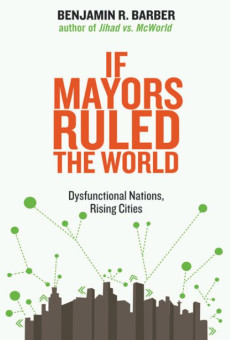
If Mayors Ruled the World: Dysfunctional Nations, Rising Cities
Benjamin R. Barber
432 pages, Yale University Press, 2013
City residents may well shudder (or laugh) at the thought of their beleaguered mayor at the helm of a global order. The work of getting garbage picked up, taxes collected, streets cleaned, and wastewater treated is more than enough for most municipal chiefs to handle.
Yet it is precisely this “get it done” attitude that makes municipal leadership so vital. Benjamin Barber, a senior research scholar at the City University of New York, argues that the twelve mayors featured in his book If Mayors Ruled the World are all stars of global scope. Each of them has achieved that status by confronting a deeply ingrained social problem: Leoluca Orlando of Palermo took on the Mafia and survived to see the tables turn on local organized crime. Teddy Kollek of Jerusalem successfully navigated the religious tensions that define his city. Sheila Dikshit of Delhi overcame severe infrastructure problems in her city (and longstanding gender bias in her society) to move her community from cynicism to hope.
What these dozen mayors have in common, Barber argues, is a profound sense of interdependence. The idea of collaborating to tackle real problems in a context where effectiveness trumps ideology is replacing the dysfunctional idea of national sovereignty. “Today, after a long history of regional success, the nation-state is failing us on a global scale,” Barber writes. “It was the perfect political recipe for the liberty and independence of autonomous peoples and nations. It is utterly unsuited to interdependence. The city, always the human habitat of first resort, has in today’s globalizing world once again become democracy’s best hope.”
Barber contends that supra-national bodies such as the United Nations, the G8, and the G20 are ineffective because member nations fight to remain sovereign and ideologically distinct, even as they face crises that demand collaboration and pragmatic problem-solving. Mayors around the world, by contrast, must deal with the relentless, day-to-day challenge of keeping their communities intact, often amid truly difficult conditions. Barber isn’t suggesting that one morning we will wake up and find that nation- states have disappeared. Rather, he argues that failures at the nation-state level have left gaps that coordinated city leadership is well suited to fill.
To some readers, the title of the book will seem outrageous. But Barber demonstrates that many mayors are already playing an important leadership role in world affairs. They are, for instance, working to mitigate the problems that come in the wake of national posturing on climate change, security, and immigration. Cities don’t have the luxury of waiting for the G8 or the G20 to solve those problems. So they are forming new institutions of their own—for example, the C40, an international network of cities that collaborate to address climate change. Similar networks are emerging to tackle crime, economic inequality, and other issues that city-dwellers face daily. “As a tactic of the relatively powerless,” Barber notes, “mitigation gets things done, permitting progress toward networking and informal cross-border governance to continue.”
Social innovators will find that many of Barber’s ideas resonate with them. They know what it means to do more with less by discovering new combinations of existing resources. They also know how to engage with people who are different from them, and with ideas that don’t align perfectly with their own. Cities, in fact, are simply a larger instantiation of the webs of interdependence that social innovators often use to solve problems.
Barber doesn’t hold cities in an idealistic light, and he notes the contradictions that mark their economic, political, and educational systems. Many city governments focus on protecting the interests of a powerful elite. (Think of Palermo during the period when the Mafia ran it.) Cities can also be brutally uncaring places for those at the grinding edge of the local economic engine. And yet, Barber suggests, cities are at the forefront of efforts to narrow such gaps in power and wealth. “Formal equality,” he contends, “is unlikely to yield equal opportunity unless people can live, ride, work, learn, and play together in cities whose neighborhoods are voluntary communities rather than walled ghettos.”
Nation-states still function today, and cities aren’t going to change that. What can change, however, is the role that cities play in connecting their citizens to structures of global governance. Barber puts forth a detailed proposal for a global parliament of mayors that would complement supranational bodies and promote strategies to improve global collaboration. Some people will worry that the enormous differences between cities in size, influence, and money would slant the already deeply tilted table of world power in favor of a few megacities. Others might note that if centralized nation-states don’t crush Barber’s envisioned parliament, then the sheer logistical complexity of representing an estimated one million local political entities probably will. Realizing Barber’s lofty vision isn’t impossible, and we ought to explore his solution as other solutions fall short. But let’s not forget that the climb will be bracingly difficult.
The reality is that mayors don’t rule the world. But they do run the world—or much of it, anyway. If they continue to advance new forms of collaboration and to harness the innovative capacity in their people, they may yet reshape the landscape of global governance.

